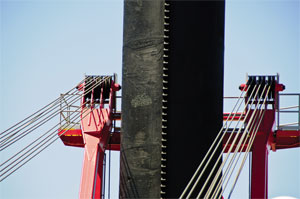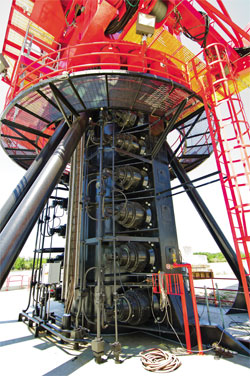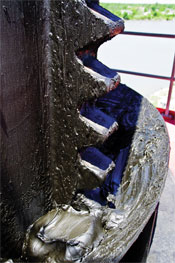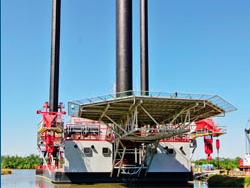The demand for offshore construction and service vessels that can operate in deeper water to capture energy from fossil fuels, wind, tide or current is increasing. So is the lofty leg length of lift boats, the dimension by which such vessels are measured.
"It seems that every couple of years we see a jump," said Allen Moore, general manager of Semco LLC.
Semco's recent construction history underlines his point. Two years ago, the Lafitte, La., company built the 280-foot KS Titan 2 (American Ship Review 2009-2010), with 280-foot legs and a working depth of 200 feet. This year comes Dixie 320, with legs of 320 feet and a working depth of 250 feet.
 |
|
The top of one of the cranes peeks out from behind one of the massive 320-foot legs. |
It seems as if there's no end in sight. In August, Levingston Corp., of Boerne, Texas, announced a letter of intent to build a 415-foot lift boat. But longer legs pose a challenge for the designer.
"As the leg length increases you have to consider the weight," said Ajay Suda, owner of A.K. Suda, the Metairie, La.-based lift boat specialist that drew up the plans for Dixie 320. "The normal instinct (is) to make them heavier. And you have to resist that instinct, because the heavier you make the legs, the less cargo — the less money-making load — the rig can carry.
"We had to design the use of steel very judiciously," Suda said. "Where the legs needed more strength we added steel and where they required less strength we removed steel."
A lift boat is a self-propelled platform with three legs that are lowered to the seabed on site. After their pads are firmly planted in the mud bottom, the platform is jacked up to the rig's working height.
Lift boats are sometimes confused with jackup rigs, and both operate in much the same way, first lowering their legs and then jacking themselves up. But they're built for different purposes and conditions. The jackup rig, which has to be towed to a work site, is much heftier and is usually employed as an oil-drilling platform. The lighter and nimbler lift boat is more likely to be carrying out repair or maintenance or working on offshore construction.
"Even though they look alike, a jackup and a lift boat are, in philosophy at least, a good bit different from each other," said Moore. "A jackup rig is designed to withstand hurricanes and not run from a storm. A lift boat, because it's self-propelled, has to be economical to move. It can stand a certain amount of storm, but usually has to move into shallower water or a dock to withstand a hurricane."
 |
|
This is what the base of the cranes looks like. |
In normal working conditions, jacked up 70 feet above the water with a full deck load, Dixie 320 can work in up to 12-foot waves and 70-knot winds. In survival mode, hunkered down in shallower water, Dixie 320 can take 100-knot winds and much larger waves.
"A big jackup that's drilling with pipe in the hole usually can't break and run very fast, so they're built to withstand the worst of the worst," said Moore.
The deck area on a lift boat makes an excellent platform for a range of offshore projects. The vessel can edge up to an oil platform, drop the legs, jack up to the platform level, bridge the gap with a gangway and act as a working platform and hotel for the rig's construction and operating crews. Dixie 320 will handle loads up to 1,250 short tons on a workable deck area of 13,500 square feet.
"This vessel will have one of the highest percentages of open deck for its size," said Suda, the designer. "We try to push as much of accommodations — as far back on the deck as possible. The generators are hanging off the transom because below the heliport is always dead space. — If we could have gone further aft, we would have."
The lift boat's legs are 9 feet 6 inches in diameter and are lined on either side with a row of gear teeth, called the gear rack. The hull is jacked up using a rack-and-pinion system. The towers have 12 drive gears called pinions that engage the gear teeth and power the legs up and down.
Diesel-electric power on Dixie 320 is produced by four Caterpillar 3512 DITA 1,750-kW diesel generators that feed power to four U.S. Motors AC 5812 electric motors, each rated at 1,150 hp. The motors turn two shafts through Twin Disc MG 2544-24 reduction gears with a ratio of 3.98:1. The Rice Kaplan 85.25-inch diameter, 76-inch pitch, .55 DAR stainless steel propellers fit in 86-inch stainless steel Kort nozzles. There is also an Omega 1,072-hp steerable thruster located at the center of the bow. A 250-kW Caterpillar C9 diesel acts as the emergency generator.
 |
|
The lift boat’s wheelhouse, on the fifth deck of the superstructure, which is located on the stern end of the main deck. A heliport hangs off the transom. |
"With a diesel-electric system, when the rig is working at a platform for example, you can put any number of pieces of service equipment on the deck of the lift boat and run them off the boat's power," said Semco's Moore. "You don't have to have separate diesel engines to run the individual pieces of equipment."
"When we're jacked up, we're using very little of the power that we're capable of producing," said Moore. "Basically the only things that power is used for are the cranes, air conditioning and lights."
Suda, the designer, agrees. "What we have done — is introduced flexibility as a power plant that is running the entire vessel," he said. "Whatever part of the vessel needs power, it draws accordingly."
The difference in the number of diesels that are needed to run the diesel-powered Titan class versus the electric-powered Dixie class is considerable. The Titans have nine diesels: two for propulsion, two generators for power, two to run the hydraulic packs for the cranes and two for jacking up the rig, plus an emergency backup.
"On the Dixie we've got four main generators and an emergency backup and we're running a lot more power," said Moore. "And there are a lot fewer things that can go wrong."
The design of the cranes on Semco's Titan- and Dixie-class lift boats is noteworthy in that they're mounted around the port and starboard legs. Semco's associate company, Seatrax, designed the cranes. Based in Houston, Seatrax specializes in developing offshore cranes for the marine industry. Mounting the cranes on the legs creates much more working deck area and allows a 360-degree arc of travel for the booms, whereas typical lift boat cranes are mounted on deck between the legs.
 |
|
Teeth line the lift boat’s legs on either side in what is known as the “gear rack.” |
"The Seatrax design is very unique," noted Suda. "They have a very small footprint — and that also was a challenge when it came to leg design, because you've got 325 tons of lifting capacity in one crane in one leg at a time."
The cranes on Dixie 320 are rated at 325 tons at 55 feet with 160-foot lattice booms. They are also electric-over-hydraulic powered, a system that is gaining in popularity wherever enough electrical capacity is available. The main advantage: They draw their operating power from the lift boat's excess electricity, eliminating the need for additional diesel engines.
The primary function of the two 1,250-gpm submersible pumps is to preload the rig to simulate storm loads and then set the pads into the seabed deep enough to withstand storms. Once the pads are set, the water is dumped back into the sea and the lift boat is jacked up to working height. At that point the hull is well out of the water and lacks a sea chest for the water maker, the sewage system and fire fighting. "Usually one of the pump's hoses is lowered back into the water to act as an extended sea chest," said Moore.
Dixie 320 is 273 feet long with a beam of 129 feet and a heliport capable of landing a Bell 212 helicopter or its equivalent. Much of the boat is devoted to its superstructure, which rises from the stern end of the main deck in five levels. On the main deck are the mess, VIP mess, galley, washup room and boot lockers, laundry and a five-bed hospital.
On the next three levels ascending are the offices, lounges, a theater, an exercise room and bunks for 100 personnel in two-person staterooms, each with private baths. The air conditioning is a chilled-water system. The top level is the wheelhouse, and it is a spacious one, with a full slate of navigation and electronic equipment (box, left).
Moore speculates that beyond a certain length, lattice leg construction will replace pipe leg construction to use metal more efficiently. Suda fervently agrees: Lattice legs, he says, are the future for lift boats over 260 feet.
As for the market, both Suda and Moore say it's flat right now, at least for big boats, and at press time Dixie 320 was still waiting for a contract. But both see a future for them.
"I think the big lift boats have a good market even just from the standpoint of platform abandonment and removal," said Moore.
As for Suda, he has his eyes on a different market: wind farms. "If you go into the windmill market, 300, 320 is going to be the most popular size," he said.

